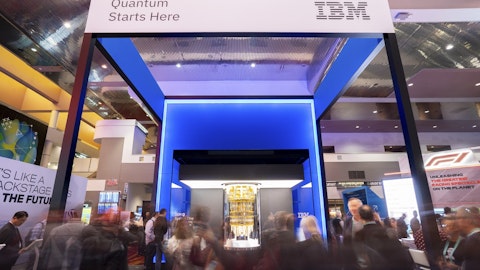And then, once they understand that and are bought into it to help them transition those proofs of concept into production applications and then deploy them in production, at which point, we put in place a production agreement that is primarily quantum compute as a service agreement. So, it starts with a professional services agreement and then it transitions to a production application deployment quantum compute as a service agreement. And so, the work that needs to be done to effect the transition from proof of concept to quantum compute as a service is complete the PoC, help them benchmark it, help them understand the value and the ROI, help them understand how to move it into production and then support them in the work to actually move it into production.
I will tell you that we expected at the beginning of last year that this process would move a bit faster than it actually has moved. So, while we were really pleased to see the transition to production starting in Q4. And we see that, we have the ability to move many more applications into production through the course of this year. It has taken us longer than we expected. But a big focus for us right now is how to shorten that timeline. And at Analyst Day, we talked a little bit about this when we described our verticalization strategy and the fact that we believe by focusing on specific use cases in specific verticals, we will learn with our customers how to, A, validate the value more quickly and, b, help them move into production more quickly.
David Williams: Great. Thanks so much for the color there. Certainly appreciate it. And just one last one, just wanted to tell congratulations to Trevor on his promotion there. Thanks.
Alan Baratz: I will pass that on to him. Thank you.
John Markovich: Thank you.
Operator: Our next question will come from Harsh Kumar with Piper Sandler. Please go ahead.
Harsh Kumar: Hey, Alan, John, huge congratulations. If I can use the term, seems like the dream is coming true. I wanted to ask about a specific application that you had in your press release that you mentioned in your commentaries. I think I’m pronouncing this correct, Zapata AI. AI is obviously all the rage, me being a semiconductor analyst, see it. You talked about reduced time for training. I was — for particularly for machine learning, which is a huge application. I was hoping maybe you could just expand on that a little bit and talk about how you’re helping there and what you’re doing there.
Alan Baratz: Yeah. Som first of all, Harsh, you may or may not recall that at Analyst Day, we showed a graph of how we expect various use cases to become enabled with various iterations of our technology or enhancements or improvements of our technology. And we actually had AI and machine learning out a couple of years from now. Now that chart was put together before we really started digging in with Zapata AI to look at what it would take to do machine learning and generative AI model training using a quantum computer to help generate samples rather than doing it all classically. And what we found was that with our Advantage2 quantum computer, and so we are working with Zapata on the 1,000 qubit Advantage2 system, we are actually able to do it quite well today.
Now, it’s a little bit early to be definitive on this, but what I can tell you is that, the early results are demonstrating that we are able to do a better job of training models, more accurate, more rapidly, and here’s a really important point, with lower power consumption. And so, we’re very excited about that. This is not a research experiment. We put this relationship in place with Zapata to bring a product to market together. And so, there is a period of time of a few months upfront to build out the product and validate that it achieves the goals that we set for ourselves and then to get it in the market. And that is progressing really well. So, we’re quite excited because it really accelerates our move into generative AI by a couple of years.
But moreover, I actually think it accelerates quantum and AI by a number of years.
Harsh Kumar: Fantastic. And then, I think at your Analyst Day, I think you had shown a obviously, the 1,000 qubit system, but I think you were talking about one that was the next generation, the 1,200 qubit system, I believe, from my memory here. Is that in production? Is that helping out for some of the applications, or do you expect quite a bit of dramatic breakthrough as you move into your newer system?
Alan Baratz: So, the Advantage2 1,000 qubit system is now in our Leap cloud service and it is accessible to all customers. So, they can either run on the 5,000 qubit advantage processor or the new 1,200-plus qubit Advantage2 Processor. And many of our customers are starting to run on the Advantage2 Processor, because it is a more powerful system even with 1200 qubits.
Harsh Kumar: Great. Thanks. That was all I had. Thank you. Congratulations, guys.
Alan Baratz: Thank you.
John Markovich: Thank you.
Operator: Thank you. Our next question comes from Richard Shannon with Craig-Hallum. Please go ahead.
Richard Shannon: Well, hi, guys. Thanks for taking my question. [indiscernible] noise here driving down the freeway. I did want to follow-up on the topic of AI here that Harsh just brought up and maybe a couple other permutations on this topic. First of all, you’re talking about improvements in training. Just to be clear, are we talking about training of really large language models or smaller ones or a range? Kind of give us a sense of what you have experience with? And then I guess the follow-on here is, Alan, I think you talked about accelerating the timeframe for quantum and AI to intersect here. I mean, when are you expecting to see production revenues or at least some amount of revenues coming from these kinds of applications? Thanks.



